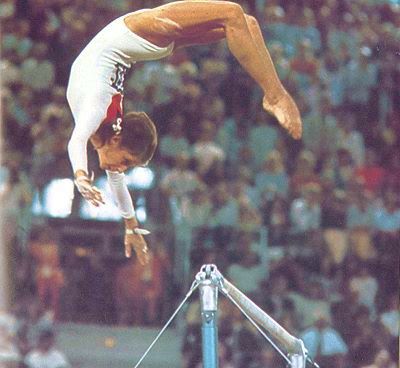
Thursday, April 30, 2009
History of US gymnastics
Events
Wednesday, April 22, 2009
Bill Roth

Roth was an outstanding all-around gymnast at Temple and earned a host of honors. In 1990, he was a NCAA All-American in floor exercise and vault. He was the Eastern Intercollegiate Gymnastics League champion in 1989, 1990 and 1992. He owns the Temple record for all-around, vault and horizontal bar. Roth competed in the 1994 and 1996 world championships. He was a member of the United States National team from 1989-1996. He made US Championships history in 1990 when he scored the first perfect 10.00 with his optional high bar routine. He earned five gold medals at the 1990 Olympics Festival.
Rhythimic Gymnastics

Rhythmic gymnastics is a sport in which single competitors or pairs, trios or even more (generally five) manipulate one or two apparatus: rope, hoop, ball, clubs and ribbon. Rhythmic gymnastics is a sport that combines elements of ballet, gymnastics, theatrical dance, and apparatus manipulation. The victor is the participant who earns the most points, as awarded by a panel of judges, for leaps, balances, pivots, flexibility, apparatus handling, and artistic effect.
The governing body, the Fédération Internationale de Gymnastique (FIG), changed the Code of Points in 2001, 2003, 2005, and 2008 to emphasize technical elements and reduce the subjectivity of judging. Before 2001, judging was on a scale of 10 like that of artistic gymnastics. It was changed to a 30-point scale in 2003 a 20-point scale in 2005, and in 2008 was changed back to 30. There are three values adding up to be the final points—technical, artistic and execution.
International competitions are split between Juniors, under sixteen by their year of birth; and Seniors, for women sixteen and over again by their year of birth. Gymnasts typically start training at a very young age and those at their peak are typically in their late teens or early twenties. The largest events in the sport are the Olympic Games, World Championships, and Grand-Prix Tournaments.
Leotards
Jay Thorton
 Jay Thornton's hometown is Augusta Goergia , Jay now lives in Colorado. He was born in September 9 ,1997 in Tacoma Washington. Jay's coach was Ron Brant and Vitaly Marinich. He went to the University of Iowa , he got his degree in economics. Jay's favorite events is the high bar and floor exercise. He began gymnastics in 1882.He joined the senior Nationals in 1994 - 2000. He also joined the jr. National team in 1990-1994. Jay is the son of Dr.John Thornton and Billie Vaugn. He has four siblings. Jay married Mary Anna Moody in November 21, 1974
Jay Thornton's hometown is Augusta Goergia , Jay now lives in Colorado. He was born in September 9 ,1997 in Tacoma Washington. Jay's coach was Ron Brant and Vitaly Marinich. He went to the University of Iowa , he got his degree in economics. Jay's favorite events is the high bar and floor exercise. He began gymnastics in 1882.He joined the senior Nationals in 1994 - 2000. He also joined the jr. National team in 1990-1994. Jay is the son of Dr.John Thornton and Billie Vaugn. He has four siblings. Jay married Mary Anna Moody in November 21, 1974
Monday, April 20, 2009

Shannon Miller is perhaps America’s most decorated woman gymnastics champion. With an impressive tally of 7 Olympic medals and 9 World Championship all-around titles, Shannon grabbed public attention at the 1992 Barcelona Olympics. She was part of the Magnificent Seven who were part of the 1996 Olympic team.

Mary Lou Retton came to be known as the ‘little pixie’ of the 1984 Olympic Gymnastics events. Her muscular and athletic form was a departure from the lithe forms so associated with woman gymnasts. A gold medal winner at the 1984 Olympics, she retired from active competition and was a fixture on many commercials. She was responsible for giving America its first Woman Gymnastics gold medal.

Olga Korbut won over the hearts of people not just with her gymnastics but her winning smile. Olga was responsible for turning women’s gymnastics into a sport for young girls. Olga was extremely flexible and caught audience attention with her back flip on the high bar and back tuck on the beam. She used music to good advantage for her floor exercises routine.
Shawn Johnson

In 2007, won every major event entered, including the American Classic, the American Cup, the Pan Am Games, the U.S. Championships and the World Championships.
Became the fourth American gymnast to win the World Championships, and only the second American gymnast to win three gold medals in a world event.
Governor Chet Culver declared October 17 as Shawn Johnson Day in the state of Iowa.

At 13, Nadia Comaneci was the youngest girl gymnast to ever win the European Championship. A protégé of Bela Karolyi, Nadia won the Romanian Junior Championship at the tender age of 9. She mesmerized crowds at the 1976 Montreal Olympic Games. Her remote personality added to the general air of mystery around her. After battling many ghosts from her past, she escaped from Budapest in 1989 and arrived in New York seeking a free life.
History Of Gymnastics

•In the 1830s, the sport of gymnastics was introduced to United States and its school systems by such immigrants as Charles Beck, Charles Follen and Franci Lieber.
•In 1881 the International Gymnastics Foundation [GF] was formed.
•The organization pioneered the international competition.
•In 1883 The Ammature Athletic Union [AAU] Union was formed.
Gymnastics started in Ancient Greece, 776 B.C.
In Ancient Greece they would use gymnastics to train for wars.




